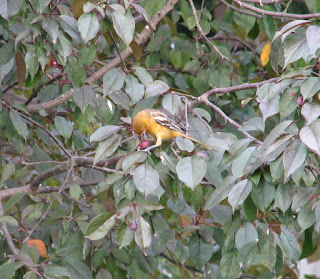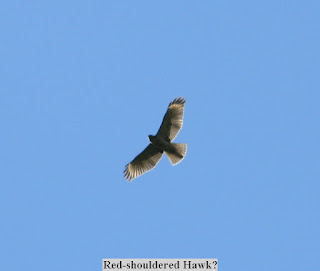

PART II-THE HOODED WARBLERS
I was in my truck supposedly heading back home. -(I say supposedly, because I rarely make it home on my first attempt. I usually have one of those imaginary light bulbs go off over my head as I suddenly think of another place to look for birds). As I was driving, it occurred to me that I had not made one visit to nearby Hurd Park this year. Three years ago, I had seen my first and only Hooded Warblers there. I wondered if there was any chance that I might see them again in the same area. I felt it was very unlikely, but not impossible.
I was able to locate the same trail that I had walked three years ago. It was a sunny morning, and already nearing 10 am by now. I noticed right away, that the birds seemed to be surprisingly vocal in this area. The woodpeckers and Pewee were the loudest, but I was tuning in to the what sounded like some sort of Warbler in the distance. I came to a small open area along the wooded path. I heard the sound the warbler again. I was a bit excited, because I knew i was not one of the more common warbler songs that I was familiar with. I caught a glimpse of a small bird landing on the outer limb of a tree. Just as I was getting ready to get a look at the bird, an older gentleman with a barking dog approached me. We chatted a bit about his dog which had gray hairs but was only a puppy. So I lost the opportunity to see this bird for the moment. As I walked further along the path, I heard the same warbler song -only now, it was coming from 3 different locations at the same time!
It was on my way back, that I got a great look at a beautiful male Hooded Warbler. The male is easy to identify, because no other warbler has a completely black hooded appearance. After it flew off, I had a look at a second male Hooded Warbler. Although I hadn't actually seen the warblers singing, I was sure it must have been the Hooded Warblers. I tried to get pictures or film one, but it they always moved before I could snap a picture. I decided to record the singing on my camera with the built in microphone before returning home.
When I returned home, I reported my findings to an open birding discussion line we have in Connecticut. I described what I had seen, and mentioned how I had heard 3 of them singing. Shortly after I sent my report in, I felt an unsettling feeling came over me.-What if the warblers I heard singing weren't the Hoodeds? What if they were another species that I just hadn't seen?-It wouldn't be the first time I made a mistake in identifying something because I jumped to conclusions. I decided to check out the audio that I recorded and see if I could confirm the identity of the singer(s).
The audio turned out to be pretty good. The song was similar to a Hooded Warbler recording that I compared it to---but it wasn't an exact match. I decided to send the audio clip out to a couple of birders including Vern from Big Spring Birds. Between Vern's birding contacts and mine, I was able to get a definitive response. The audio was indeed, that of a Hooded Warbler. It was however, one of it's alternate songs. All was well again. Thanks to Vern and Paul C. for helping me out! Unfortunately, I couldn't figure how to upload an audio clip to blogger. Overall, it was an interesting learning experience for me.




 Several Orioles, including this male, joined in for the fun as well. I don't think he wanted to leave but..........
Several Orioles, including this male, joined in for the fun as well. I don't think he wanted to leave but.......... A Blue Jay came barrelling in and got down to some serious bathing. These photos aren't really giving you the whole picture. There were many other birds at the bath during the same period including: Cardinals, Chickadees, and Red-winged Blackbirds. The action was non-stop. I wonder what triggered these birds to get so active all at the same time?
A Blue Jay came barrelling in and got down to some serious bathing. These photos aren't really giving you the whole picture. There were many other birds at the bath during the same period including: Cardinals, Chickadees, and Red-winged Blackbirds. The action was non-stop. I wonder what triggered these birds to get so active all at the same time?




 I will usually wait for a very cold day or a snowstorm, when the birds are extra hungry. I smash the acorns up before serving them. The birds go after them with much enthusiasm. By the way, does anyone know what kind of tree is in the top photo? I have one in my yard, and the birds gobble the berries up quickly!
I will usually wait for a very cold day or a snowstorm, when the birds are extra hungry. I smash the acorns up before serving them. The birds go after them with much enthusiasm. By the way, does anyone know what kind of tree is in the top photo? I have one in my yard, and the birds gobble the berries up quickly! 














 My stay here was brief due to the arrival of halfa dozen atv's which aren't even supposed to be there. I saw this handsome butterfly on the way out. I know I've seen this butterfly a few times this year but I lost my butterly guide.-Is this the Spicebush Swallowtail?
My stay here was brief due to the arrival of halfa dozen atv's which aren't even supposed to be there. I saw this handsome butterfly on the way out. I know I've seen this butterfly a few times this year but I lost my butterly guide.-Is this the Spicebush Swallowtail?
 I don't even have a mushroom book. Do you have any idea what kind it is? I hear an
I don't even have a mushroom book. Do you have any idea what kind it is? I hear an  Rats!-It came out blurry. That's o.k., I'm putting it in anyway.
Rats!-It came out blurry. That's o.k., I'm putting it in anyway.  I think that's one of those Pearl Crescent Butterflies-what do you think? Well it's been fun. Maybe we'll do a little birding again in the fall when the weather is nicer and there's more birds around.-Thanks-have a nice weekend!
I think that's one of those Pearl Crescent Butterflies-what do you think? Well it's been fun. Maybe we'll do a little birding again in the fall when the weather is nicer and there's more birds around.-Thanks-have a nice weekend!